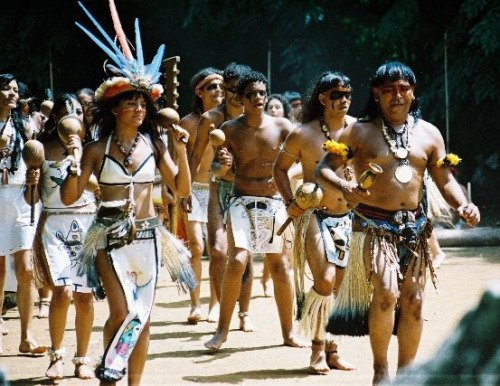
With the advent of new technologies that map the mitochondrial DNA of our ancestors, genetic scientist and anthropologist have scurried to the Dominican Republic in search for an understanding of pre-Columbian human migration and origin. But because of the checkered history of the Dominican Republic and its infamous perceptions of race, the scientific inquiries in the island have been confronted with some resistance.
In 2010, Professors Juan Carlos Martinez-Cruzado and Dr. Fermin Mercedes de la Cruz from the Puerto Rico University presented their findings which showed that at least 15% of Dominicans possess indigenous mitochondrial DNA.[1] And in 2015, the Genographic Project – an initiative funded by National Geographic that uses advanced DNA analysis and works with indigenous communities to answer questions of human origins – launched its biggest study in the Dominican Republic, hoping to involve 1000 individuals and collect their DNA samples and demographic histories.[2] Before these studies and findings, scholars and academics assumed that indigenous existence in the form of Taino culture and communities were extinct. Christopher Columbus’s unreliable account of Taino extinction and mass death became etched in stone for scholars studying the colonial Caribbean. Moreover, the inaccurate and haphazard census data taken by colonizing Spaniards discounted those runaway, rebellious Taino men and women who made their homes in the mountains of Hispaniola.
Lynn Guitar, professor of anthropology in the Dominican Republic and a resident of the island, advocated for a more inclusive study of race in the Dominican Republic much before the recent genetic findings. Lynn Guitar’s work interrogates race in the D.R. through a racial paradigm that focuses on the physical and cultural miscegenation of the Indian, African and European – a tripartite racial identity that embraces the whole dazzling project of colonization.[3] However, Guitar’s anthropological re-reading of the canonized sources that the Spaniards left strike at the heart of the fraught conversations about race in the D.R. that are taking place recently.
The recent deportation of thousands of Haitians from the D.R. in the summer of 2014, after a supreme court ruled that children born to undocumented foreign parents since 1929 have never been entitled to Dominican nationality, places the conversation of a tripartite Dominican racial identity in an awkward position. The “Indio” (Indian) racial label has been historically exploited in the Dominican national imagination to create a distinction between the black Haitians and brown Dominicans. Rafael Leonidas Trujillo (1930-1961) during his thirty year kleptocratic reign is infamously known for his massacre of Haitains in the 1930s and for issuing ID cards that identified the race of all Dominicans as Indio (Indian). The D.R.’s unique eighteenth century independence process, not from a European white power, but from their black, slave-revolting neighbors adds to the complexities of race in the island – a complexity derived from discrete historical experiences that mixes race with other social factors and not only the color of one’s skin. It is no wonder that the discourse on race in the Dominican Republic, and the Spanish Caribbean at large, has been compelled to adopt the stringent binaries of black and white to combat the D.R.’s endemic racism.
Yet the solution in the Dominican Republic may well lie in the opposite approach: that of embracing a more complex racial identification that doesn’t heed to the culturally imperialist notions of strictly black and white, as the United States has done with its Jim Crownian “one drop rule.” The Island that shares the nations of Haiti and the Dominican Republic has been dubbed “the cradle of blackness in the Americas.”[4] But as new genetic and anthropological research gains headway, the Dominican Republic and the Spanish Caribbean are looking more like the cradle of myriad racial and ethnic components that yield ground for new ways of studying blackness, whiteness and indigeneity.
[1] http://www.dominicantoday.com/dr/local/2010/6/17/36042/Study-finds-Taino-genes-in-15-of-Dominicans [2] http://voices.nationalgeographic.com/2015/11/06/genographic-project-helps-launch-new-ancestry-study-in-the-dominican-republic/ [3] Lynne Guitar, Ferbel-Azcarate Pedro, Eztevez Jorge “Ocama-Daca Taíno (Hear Me, I am Taíno): Taíno Survival on Hispaniola, Focusing on the Dominican Republic,” in Indigenous Resurgence in the Contemporary Caribbean: Amerindian Survival and Revival ed. Maximilian C. Forte (New York: Peter Lang, 2006). [4] Silvio page 2
pretty good
Downvoting a post can decrease pending rewards and make it less visible. Common reasons:
Submit
Very interesting
Downvoting a post can decrease pending rewards and make it less visible. Common reasons:
Submit
Congratulations @renec1123! You received a personal award!
You can view your badges on your Steem Board and compare to others on the Steem Ranking
Vote for @Steemitboard as a witness to get one more award and increased upvotes!
Downvoting a post can decrease pending rewards and make it less visible. Common reasons:
Submit